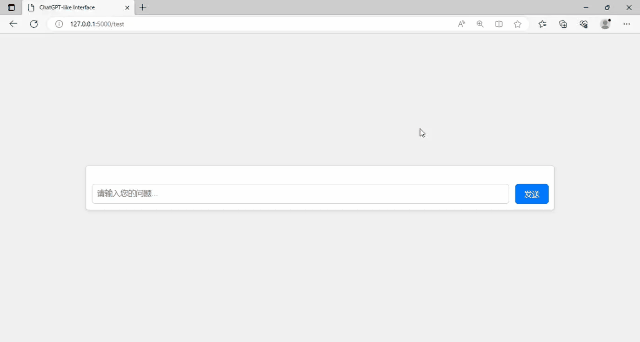基於GPT搭建私有知識庫聊天機器人(六)仿chatGPT打字機效果
2023-07-21 18:00:30
文章連結:
在前幾篇文章中,我們已經瞭解瞭如何使用 GPT 模型來搭建一個簡單的聊天機器人,並在後端使用私有知識庫來提供答案。
現在,我們將繼續改進我們的聊天介面,實現類似chatGPT打字機的效果聊天,避免長時間等待介面資料返回,以提升使用者體驗。
1、效果展示

PS:一本正經的胡說八道
2、Server-Sent Events (SSE) 技術簡介
在本篇文章中,我們將使用 SSE 技術來實現打字機效果輸出。SSE 是一種 HTML5 技術,允許伺服器向用戶端推播資料,而不需要使用者端主動請求。通過 SSE,我們可以在伺服器端有新訊息時,實時將訊息推播到前端,從而實現動態的聊天效果。

3、前端程式碼
首先,我們需要編寫前端的JavaScript 程式碼,以便使用 SSE 技術與伺服器進行實時通訊。
<!DOCTYPE html>
<html>
<head>
<title>ChatGPT-like Interface</title>
<link rel="stylesheet" href="static/styles.css">
</head>
<body>
<div class="chat-container">
<div class="chat-history" id="chatHistory">
<!-- Chat messages will be dynamically added here -->
</div>
<div class="user-input">
<input type="text" id="userInput" placeholder="請輸入您的問題...">
<button id="sendButton">傳送</button>
</div>
</div>
<script>
// Your existing chat interface code here...
// Server communication code
var eventSource; // Declare the eventSource variable outside the click handler
document.getElementById("sendButton").addEventListener("click", function () {
var userMessage = document.getElementById("userInput").value.trim();
if (userMessage === '') {
alert('Please enter a message!');
return;
}
appendMessage('user', userMessage); // Add the user's message to the chat history
// Close the previous SSE connection (if exists)
if (eventSource) {
eventSource.close();
}
// Establish SSE connection with the user's message as a parameter
eventSource = new EventSource(`/print_stream?question=${encodeURIComponent(userMessage)}`);
eventSource.onmessage = function (event) {
var botMessage = event.data;
appendMessage('bot', botMessage);
};
eventSource.onerror = function (error) {
console.error("Error occurred with SSE connection:", error);
// Handle the error if necessary
isFirstToken = true;
eventSource.close();
};
document.getElementById("userInput").value = '';
});
var chatHistoryDiv = document.getElementById("chatHistory"); // 獲取 chatHistory 的元素
var isFirstToken = true; // 用於跟蹤是否是第一次返回 token
function appendMessage(sender, message) {
if (isFirstToken) {
// 如果是第一次返回 token,建立新的 <div> 元素,並將 isFirstToken 設定為 false
var messageDiv = document.createElement('div');
messageDiv.className = `chat-message ${sender === 'user' ? 'user-message' : 'bot-message'}`;
chatHistoryDiv.appendChild(messageDiv);
if(sender === 'bot') {
isFirstToken = false;
}
} else {
// 如果不是第一次返回 token,直接獲取最後一個 <div> 元素,將新的訊息內容追加到現有的元素中
var messageDiv = chatHistoryDiv.lastElementChild;
}
messageDiv.innerText += message; // 將新的訊息內容追加到 <div> 中
chatHistoryDiv.scrollTop = chatHistoryDiv.scrollHeight; // 將卷軸捲動到最底部
}
</script>
</body>
</html>
為了實現對話效果,我們需要調整 CSS 樣式表中的部分樣式。以下是 CSS 樣式表:
body {
font-family: Arial, sans-serif;
background-color: #f0f0f0;
margin: 0;
padding: 0;
display: flex;
justify-content: center;
align-items: center;
min-height: 100vh;
}
.chat-container {
width: 800px;
border: 1px solid #ccc;
border-radius: 5px;
box-shadow: 0 2px 6px rgba(0, 0, 0, 0.1);
background-color: #fff;
overflow: hidden;
}
.chat-history {
max-height: 800px;
overflow-y: auto;
padding: 10px;
}
.chat-message {
margin-bottom: 10px;
padding: 8px 12px;
border-radius: 20px;
max-width: 70%; /* 設定最大寬度,使得訊息在一行中不會過長 */
align-self: flex-end; /* 靠右顯示 */
word-wrap: break-word; /* 處理長文字的自動換行 */
overflow-wrap: break-word; /* 處理長文字的自動換行 */
}
.user-message {
color: #007bff;
background-color: #e6e6e6; /* 使用者訊息氣泡背景色 */
text-align: right; /* 靠右顯示文字內容 */
align-self: flex-end; /* 靠右顯示氣泡 */
margin-left: auto; /* 新增額外的間距,讓氣泡靠右 */
}
.bot-message {
color: #555;
background-color: #d9edf7; /* 機器人訊息氣泡背景色 */
text-align: left; /* 靠左顯示文字內容 */
align-self: flex-start; /* 靠左顯示氣泡 */
margin-right: auto; /* 新增額外的間距,讓氣泡靠左 */
}
.user-input {
display: flex;
align-items: center;
padding: 10px;
}
#userInput {
flex-grow: 1;
padding: 8px;
border: 1px solid #ccc;
border-radius: 5px;
margin-right: 10px;
}
#sendButton {
padding: 8px 15px;
border: none;
border-radius: 5px;
background-color: #007bff;
color: #fff;
cursor: pointer;
}
#sendButton:hover {
background-color: #0056b3;
}
4、後端程式碼
本文依舊使用的langchain框架實現存取openAI,以及利用回撥函數接收token資料。
首先,是API入口:
from flask import Flask, request, Response, stream_with_context
@app.route("/print_stream")
def print_stream():
question = request.args.get('question')
ans = search_schedule(question)
return Response(stream_with_context(ans), content_type='text/event-stream')
其次,是存取openAI程式碼(不太瞭解的可以看下前幾篇文章):
def search_schedule(query: str) -> str:
stream_to_web = StreamToWeb()
llm = ChatOpenAI(temperature=0,
model="gpt-3.5-turbo-0613",
callback_manager=CallbackManager([stream_to_web]),
streaming=True
)
bus_tools = [BusTool()]
open_ai_agent = initialize_agent(bus_tools,
llm,
agent=AgentType.OPENAI_FUNCTIONS,
verbose=True)
chain_thread = threading.Thread(target=process_query,
kwargs={"question": query,
"open_ai_agent": open_ai_agent})
chain_thread.start()
resp = stream_to_web.generate_tokens()
return resp
注意:上面呼叫openai部分程式碼必須使用非同步執行,才能做到一邊接收返回token,一邊返回前端,否則無法實現打字機效果。
最後,打字機效果核心程式碼:
class StreamToWeb(StreamingStdOutCallbackHandler):
def __init__(self):
self.tokens = []
# 記得結束後這裡置true
self.finish = False
def on_llm_new_token(self, token: str, **kwargs):
self.tokens.append(token)
def on_llm_end(self, response: any, **kwargs: any) -> None:
self.finish = 1
def on_llm_error(self, error: Exception, **kwargs: any) -> None:
print(str(error))
self.tokens.append(str(error))
def generate_tokens(self):
while not self.finish or self.tokens:
if self.tokens:
data = self.tokens.pop(0)
yield f"data: {data}\n\n"
else:
pass
注意:yield f"data: {data}\n\n" ,data是前端接受資料的引數,\n\n在SSE要求中必須新增。
5、總結
通過使用 SSE 技術和打字機樣式輸出,我們成功改進了聊天機器人的介面,實現了更加動態和流暢的聊天體驗。這樣的使用者介面使得聊天機器人更加接近真實對話,提升了使用者體驗。
作者:伊力程式設計
路過別錯過,點個關注,謝謝支援